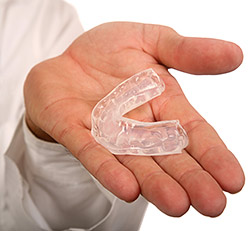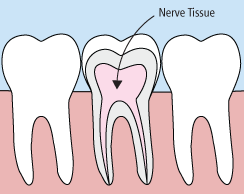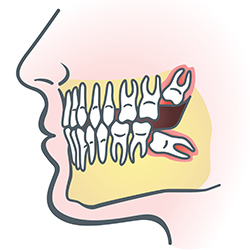Common Procedures
Topics on this page

Regular Exams and Cleanings

Regular exams are a critical part of maintaining your child’s oral health. During your son or daughter’s regular exam, we will:
- Check for any problems that may not be seen or felt
- Look for cavities or other signs of tooth decay
- Inspect the teeth and gums for gingivitis and signs of periodontal disease
- Perform a thorough teeth cleaning
Your child’s exam will take about 45 minutes. Each regular exam includes a detailed teeth cleaning, during which we will clean, polish, and rinse the teeth to remove any tartar and plaque that have built up on the tooth’s surface.
Visiting our office every six months gives you the chance to ask Dr. Jensen any questions you may have about your youngster’s oral health. Regular exams are offered by appointment only, so please contact our practice today to schedule your child’s next dental exam and teeth cleaning.
Stainless Steel Crowns

A crown is also known as a cap. It sits on a tooth as a protective cover to prevent it from chipping or breaking during chewing. A crown extends the life of the tooth.
Primary crowns are typically placed when a patient is at high risk for decay due to poor oral hygiene or rampant decay, or when more than two teeth with two or more surfaces need treatment.
Primary crowns are routinely placed as the treatment of choice in these patients as guidelines from the American Academy of Pediatric Dentistry indicate. Stainless steel crowns can also be placed on permanent teeth as well.
White Faced Stainless Steel Crowns


To make the stainless steel crowns look more aesthetic, especially on the front teeth, they are available with a pre-veneered plastic facing. These crowns look better because from the front they look “white.”
In order for the white facing to adhere to the metal, extra bulk must be added, which can make these crowns look bulbous or rounded. The white facing also has a tendency to chip off over time, and expose the silver crown underneath. Chipping can occur when children grind their teeth or as a result of chewing forces on back teeth.
It is important to note that the cement used for this procedure is Fugi Glass Ionomer. A thick mix of cement is mixed by the dental assistant using 1 drop of powder and 1 drop of the liquid.
Zirconia Crowns

Anterior crowns for primary teeth can be white in color, so they are very hard and aesthetically beautiful. The procedure and indications are very similar to stainless steel crowns. White crowns take longer to prepare, require more reduction of the tooth, are more expensive, are typically used only on the front six teeth, and are not covered by Medicaid.
Pediatric zirconia crowns, like stainless steel crowns, come premade in six or seven different sizes for each tooth and are supplied in kits. To place the crowns, the damaged area is removed and the tooth prepared with occlusal and circumferential reduction to a gingival featheredge.
An appropriately sized crown is then tried on the preparation. If the crown does not fit, either another size is attempted or more tooth reduction is done until a crown is passively seated onto the preparation.
Extractions
 There are times when it is necessary to remove a tooth. Sometimes a baby tooth has misshapen or long roots that prevent it from falling out as it should, and the tooth must be removed to make way for the permanent tooth to erupt.
There are times when it is necessary to remove a tooth. Sometimes a baby tooth has misshapen or long roots that prevent it from falling out as it should, and the tooth must be removed to make way for the permanent tooth to erupt.
At other times, a tooth may have so much decay that it puts the surrounding teeth at risk, so a doctor may recommend its removal. Infection, orthodontic correction, or problems with a wisdom tooth can also require removal of a tooth.
When it is determined that a tooth needs to be removed, Dr. Jensen may extract it during a regular checkup, or request another visit for this procedure. The root of each tooth is encased within the jawbone in a “tooth socket,” and the tooth is held in that socket by a ligament. In order to extract a tooth, a dentist must expand the socket and separate the tooth from the ligament holding it in place.
Though this procedure is typically very quick, it is vital to share with the doctor any concerns or preferences for sedation.
Space Maintaniers

An empty space in the mouth due to a missing tooth is an unhealthy condition. If left untreated, empty spaces will eventually result in the loss of more teeth or crowding.
In our office, when a tooth is missing or has to be extracted, a space maintainer is recommended. Space maintainers are appliances made of metal that are custom fit to the mouth or tooth. They are small and unobtrusive in appearance. Most children easily adjust to them after the first few days.
Fillings

Almost everyone has had a cavity at some point in his or her life, mostly during childhood. This office uses both amalgam (or silver fillings) and composite (or white filling) material for restoring cavities.
A cavity is a hole in the tooth that results from decay. It usually comes from food matter on the tooth that has not been removed. This material eats away the tooth. A cavity can be very big or as tiny as a pinhole. No matter what size, once a hole is there, it must be filled or it will only get bigger.
Our office recommends amalgam fillings in most scenarios. An amalgam restoration can last 15 or more years, and a composite usually lasts about 5 to 7 years with regular dental visits. After this time, the material starts wearing down and may become “leaky” (meaning that saliva and plaque begins to seep through the filling and decay the tooth underneath the filling). This occurrence is not unusual and happens to almost everyone. The treatment is to remove the old filling and place a new one.
At first, fillings may be sensitive to cold or hard food items. This sensitivity is normal. The tooth is simply adjusting to the filling. Depending on the size of the filling, the sensitivity may last 5 to 6 months.
However, if a patient complains of pain when chewing on the tooth, the doctor needs to see the patient. The new filling may be too high, thereby causing pain during chewing. This is quickly and easily corrected by the dentist (usually in about 1 minute) by removing high spots on the filling with a handpiece and finishing burr.
Fluoride

Fluoride is effective in preventing cavities and tooth decay. It also prevents plaque from building up and hardening on the tooth’s surface. A fluoride treatment in our office takes just a few minutes.
After the treatment, your child may be asked not to rinse, eat, or drink for at least 30 minutes in order to allow the teeth to absorb the fluoride. Depending on your child’s oral health or the doctor’s recommendation, a fluoride treatment may be required every three, six, or 12 months.
Please click here for more information and consent for Silver Diamine Fluoride with Fluoride Varnish Therapy to Arrest Decay - PDF
Mouthguards

Whether your child wears braces or not, protecting his or her smile while playing sports is essential. Mouthguards help protect the teeth and gums from injury.
If your child participates in any kind of full-contact sport, the American Dental Association recommends that he or she wear a mouthguard. Choosing the right mouthguard is essential.
There are three basic types of mouthguards: the pre-made mouthguard, the “boil-and-bite” fitted mouthguard, and a custom-made mouthguard from the dentist. When you choose a mouthguard, be sure to pick one that is tear-resistant, comfortable and well-fitted for your mouth, easy to keep clean, and does not prevent your child from breathing properly.
Dr. Jensen can show your child how to wear a mouthguard properly and how to choose the right mouthguard to protect the patient’s smile.
Nightguards

If your son or daughter often wakes up with jaw pain, earaches, or headaches, or you see the child clenching or grinding his or her teeth, the youngster may have a common condition called “bruxism.” Many people do not even know they grind their teeth, as it often occurs when one is sleeping. If not corrected, bruxism can lead to broken teeth, cracked teeth, or even tooth loss.
There is an easy, non-invasive treatment for bruxism. Nightguards are a great way to prevent the wear and damage that teeth-grinding causes over time. Custom-made by our office from soft material to fit the teeth, a nightguard is inserted over your child’s top or bottom arch to prevent contact with the opposing teeth.
Root Canals

In the past, if your child had a permanent tooth with a diseased nerve, he or she would probably lose that tooth. Today, with a special dental procedure called “root canal treatment,” your child’s tooth can be saved.
When a tooth is cracked or has a deep cavity, bacteria can enter the pulp tissue and germs can cause an infection inside the tooth. If left untreated, an abscess may form. If the infected tissue is not removed, pain and swelling can result. This can not only injure your child’s jawbone, but it is also detrimental to his or her overall health.
Root canal treatment involves one to three visits. During treatment, Dr. Jensen will remove the affected tissue. Next, the interior of the tooth will be cleaned and sealed. Finally, the tooth is filled with a dental composite.
If it has extensive decay, we may suggest placing a crown to strengthen and protect the tooth from breaking. As long as your son or daughter continues to care for his or her teeth and gums with regular brushing, flossing, and checkups, the restored tooth can last a lifetime.
Please click here for information on endodontic treatment and consent:
Endodontic Information and Consent Form - PDF
Sealants
 Sometimes brushing is not enough, especially when it comes to those hard-to-reach spots in your child’s mouth. It is difficult for a toothbrush to get between the small cracks and grooves on the teeth. If left alone, those tiny areas can develop tooth decay. Sealants give your child’s teeth extra protection against decay and help prevent cavities.
Sometimes brushing is not enough, especially when it comes to those hard-to-reach spots in your child’s mouth. It is difficult for a toothbrush to get between the small cracks and grooves on the teeth. If left alone, those tiny areas can develop tooth decay. Sealants give your child’s teeth extra protection against decay and help prevent cavities.
Dental sealants are a plastic resin that bonds and hardens in the deep grooves on your child’s teeth surfaces. When a tooth is sealed, the tiny grooves become smooth and are less likely to harbor plaque. With sealants, brushing your son or daughter’s teeth becomes easier and more effective against tooth decay.
Sealants are typically applied to children’s teeth as a preventive measure against tooth decay after the permanent teeth have erupted. It is more common to seal “permanent” teeth rather than “baby” teeth, but every patient has unique needs, and Dr. Jensen will recommend sealants on a case-by-case basis.
Sealants last from three to five years, but it is fairly common to see adults with sealants still intact from their childhood. A dental sealant only provides protection when it is fully intact, so if your child’s sealants come off, let our office know, and schedule an appointment for your little one’s teeth to be re-sealed.
Wisdom Teeth
 Wisdom teeth are molars found in the very back of the mouth. They usually appear in the late teens or early 20s, but may become impacted (fail to erupt) due to lack of room in the jaw or angle of entry.
Wisdom teeth are molars found in the very back of the mouth. They usually appear in the late teens or early 20s, but may become impacted (fail to erupt) due to lack of room in the jaw or angle of entry.
When a wisdom tooth is impacted, it may need to be removed. If it is not removed, your child may develop gum tenderness, swelling, or even severe pain. Impacted wisdom teeth that are partially or fully erupted tend to be quite difficult to clean and are susceptible to tooth decay, recurring infections, and even gum disease.
Wisdom teeth are typically removed in the late teens or early twenties because there is a greater chance that the roots have not fully formed, and the bone surrounding the teeth is less dense. These two factors can make extraction easier as well as shorten the recovery time.
In order to remove a wisdom tooth, we first need to numb the area around it with a local anesthetic. Since the impacted tooth may still be under the gums and embedded in your jaw bone, Dr. Jensen will need to remove a portion of the covering bone to extract the tooth.
In order to minimize the amount of bone that is removed with the tooth, a dentist will often “section” the wisdom tooth so each piece can be removed through a small opening in the bone. Once your child’s wisdom teeth have been extracted, the healing process begins.
Depending on the degree of difficulty related to the extraction, healing time varies. Dr. Jensen will share with you what to expect and provide instructions for a comfortable, efficient healing process.

 Website Powered by Sesame 24-7™
Website Powered by Sesame 24-7™